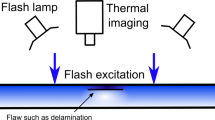Abstract
Pulse thermography of concrete structures is used in civil engineering for detecting voids, honeycombing and delamination. Quantitatively realistic numerical 3D simulation is difficult due to the arising boundary layer at the heated surface and unreliable information about material parameters and environmental conditions. We address both issues by a semi-analytic reformulation of the heat transport problem and by parameter identification. Numerical results are compared with measurements of a test specimen.









Similar content being viewed by others
Abbreviations
- c :
-
Specific heat capacity distribution (J/kg K)
- \(\bar{c}\) :
-
Surface averaged specific heat capacity (J/kg K)
- C :
-
Radiation constant distribution (W/m2 K4)
- \(\bar{C}\) :
-
Averaged radiation constant (W/m2 K4)
- g :
-
Total boundary heat flux (W/m2)
- h :
-
Heat transfer coefficient distribution (W/m2 K)
- \(\bar{h}\) :
-
Averaged heat transfer coefficient (W/m2 K)
- P 0 :
-
Steradial heating power density (W/m2)
- Q 0 :
-
Power density of radiative heating (W/m2)
- t :
-
Time (s)
- t h :
-
Heating time (s)
- T :
-
Temperature (K)
- T amb :
-
Ambient temperature (K)
- T ext :
-
External temperature distribution (K)
- T 0 :
-
Initial temperature distribution (K)
- x = (x1, x2, x3):
-
Spatial position (m)
- κ:
-
Thermal conductivity distribution (W/m K)
- \(\bar{\kappa}\) :
-
Surface averaged thermal conductivity (W/m K)
- Ω:
-
Computational domain
- Ω0 :
-
Heated front face of Ω
- ρ:
-
Density distribution (kg/m3)
- \(\bar{\rho}\) :
-
Surface averaged density (kg/m3)
References
Maldague X (2001) Theory and Practice of Infrared Technology for Nondestructive Testing. Wiley, London
Lugin S, Netzelmann U (2007) A defect shape reconstruction algorithm for pulsed thermography. NDT & E Int 40(3):220–228
Hohage T, Rap’un ML, Sayas FJ (2007) Detecting corrosion using thermal measurements. Inverse Probl 23:53–72
Marcuzzi F, Marinetti S (2008) Efficient reconstruction of corrosion proles by infrared thermography. J Phys Conf Ser 124:012033
Carslaw HS, Jaeger J (1959) Conduction of heat in solids, 2 edn. Clarendon Press, Oxford
Wedler G, Brink A, Maierhofer C, Röllig M, Weritz F, Wiggenhauser H (2003) Active infrared thermography in civil engineering—quantitative analysis by numerical simulation. In: International Symposium on Non-Destructive Testing in Civil Engineering. NDT-CE, Berlin
Brink A (2005) Einsatz der Impuls-Thermografie zur quantitativen zerstörungsfreiein Prüfung im Bauwesen. Ph.D. thesis, TU Berlin
Krishnapillaia M, Jonesa R, Marshalla I, Bannisterb M, Rajicc N (2006) NDTE using pulse thermography: Numerical modeling of composite subsurface defects. Compos Struct 75:241–249
Chaudhuri P, Santra P, Yoele S, Prakash A, Reddy D, Lachhvani L, Govindarajan J, Saxena Y (2006) Non-destructive evaluation of brazed joints between cooling tube and heat sink by IR thermography and its verification using FE analysis. NDT&E Int 39:88–95
Vavilov V, Klimov A (2002) Studying the phenomena related to the IR thermographic detection of buried landmines. In: Sixth International Conference on Quantitative Infrared Thermography. Dubrovnik, Croatia
Susa M, Ibarra-Castanedo C, Maldague X, Svaic S, Boras I, Bendada A (2007) Pulse thermography applied on a complex structure sample: comparison and analysis of numerical and experimental results. In: Fourth Pan American Conference in END. Buenos Aires, Argentina
Maierhofer C, Arndt R, Röllig M, Brink A, Wiggenhauser H, Hillemeier B, Rieck C, Walther A, Scheel H (2005) Abschlussbericht zum DFG-Projekt Struktur- und Feuchteuntersuchungen von Bauteil- und Bauwerksoberflächen mit der Impulsthermographie, Teil 1 und Teil 2. Tech. rep., BAM
Maierhofer C, Brink A, Röllig M, Wiggenhauser H (2005) Quantitative impulse-thermography as non-destructive testing method in civil engineering—experimental results and numerical simulations. Construction and Building Materials 19(10), 731–737 (2005). Non Destructive Testing: Selected papers from Structural Faults and Repair 2003
Linz P (1985) Analytical and Numerical Methods for Volterra Equations. Studies in Applied Mathematics. SIAM
Vavilov V, Klujev V (eds.) (2004) Nondestructive testing, vol. 5. Maschinostroenie (2004). Russian original
Lang J (2001) Adaptive multilevel solution of nonlinear parabolic PDE systems, lecture notes in computational science and engineering, vol. 16. Springer, Berlin
Deuflhard P (2004) Newton methods for nonlinear problems. Affine invariance and adaptive algorithms, computational mathematics, vol. 35. Springer, Berlin
Author information
Authors and Affiliations
Corresponding author
Rights and permissions
About this article
Cite this article
Weiser, M., Röllig, M., Arndt, R. et al. Development and test of a numerical model for pulse thermography in civil engineering. Heat Mass Transfer 46, 1419–1428 (2010). https://doi.org/10.1007/s00231-010-0656-9
Received:
Accepted:
Published:
Issue Date:
DOI: https://doi.org/10.1007/s00231-010-0656-9




